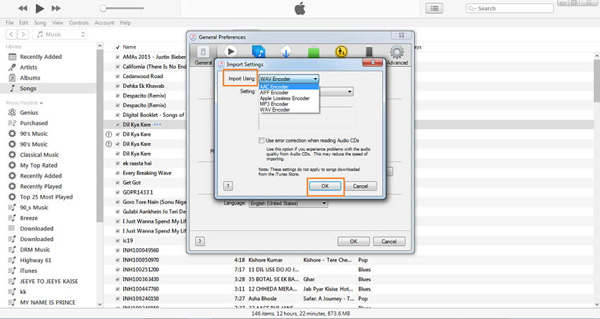
- CONVERTING A WAV FILE TO MP3 IN ITUNES HOW TO
- CONVERTING A WAV FILE TO MP3 IN ITUNES PORTABLE
- CONVERTING A WAV FILE TO MP3 IN ITUNES ZIP
Other advantages of MP3 include excellent compatibility with various programs and audio devices. Compared to lossy files, MP3 songs take up much less disk space thanks to a special algorithm. The emergence of the MP3 format was made possible by the joint efforts of a development team of almost 40 people who have been working on the project for several years. So this might be the ideal solution: keep lossless files in your iTunes library, and use the matched or uploaded versions on your iOS devices.Popular compression and lossy format with small file size and far from the highest sound quality. However, if you use the cloud to listen to files on the go, you don’t need them to be lossless, as I explained above. This means that your lossless files will never be in the cloud. If iTunes can’t match them and needs to upload them, iTunes converts them to 256kbps before uploading. If the files are matched, then they’re matched to the iTunes Store equivalents: files at 256kbps AAC. If your iTunes library contains lossless files, iTunes Match and iCloud Music Library treat them differently from other files. You may want to use iTunes Match or iCloud Music Library to keep your iTunes library in the cloud.

Using iTunes Match or iCloud Music Library with lossless files See this article for more on this conversion. While iTunes doesn’t support FLAC files, you can simply convert them to Apple Lossless, retaining the same quality. I mentioned above that you may have FLAC files that you’ve downloaded, either from websites where bands allow trading of live music or from vendors who sell lossless files in that format. Have iTunes convert your lossless files on the fly when syncing to your iOS devices.

This setting tells iTunes to convert your lossless tracks on the fly when syncing to your iOS device. I use 256kbps, but you can also choose 128 or 192. In the Options section, check Convert higher bit rate songs to, and choose a bit rate. Connect your iOS device, select it, and then click on Summary. And these files take up a lot of space on a device that has a limited amount of storage.įortunately, iTunes lets you have the best of both options. You won’t hear any difference in sound quality over the ambient background noise, and on headphones that are certainly not as good as those you use at home.
CONVERTING A WAV FILE TO MP3 IN ITUNES PORTABLE
However, if you’re listening on the go-on an iPhone, with headphones, or streamed to a portable speaker-there’s little advantage to using lossless files. Also, if you rip to lossless, you’ll have archival files, which you can later convert to any format without needing to re-rip your CDs. And lossless files sound exactly like CDs, so you’ll have the best quality for your home listening. So if you have a large music collection, you’ll need a bigger hard drive (or more than one). But why use lossless files? What’s the advantage?Īs you’ve seen above, lossless files take up a lot more space. You may also have some FLAC (Free Lossless Audio Codec) files you’ve downloaded they’re very common. You have the option to rip your CDs to Apple Lossless format. While you can tag WAV and AIFF files in iTunes, not all of these tags remain in the files if you move from your iTunes library to another computer or device. Not only do they take up a lot of space, but tags-metadata you add to the files-aren’t supported as well as with the other formats. Note that it’s generally not a good idea to use AIFF or WAV files in your iTunes library. This type of compression removes data for sounds that you can’t hear, as well as using other “psychoacoustic” techniques to compact the files. The former is the way files such as MP3s and AACs are shrunk to one-quarter, even one-tenth the size of the original files. With audio files, there are two types of compression: lossy and lossless. This seemingly magical compression algorithm looks for redundancies in data, and writes a sort of shorthand, saving a great deal of space. When you unzip-or decompress-the archive, the resulting file contains the exact same data as in the original.
CONVERTING A WAV FILE TO MP3 IN ITUNES ZIP
Let’s start with a simple question: what is compression? You’ve probably familiar with Zip compression, which lets you shrink the size of a Word file or a PowerPoint presentation for storage or to send to someone by email.

CONVERTING A WAV FILE TO MP3 IN ITUNES HOW TO
In this article, I’m going to explain what lossless audio files are, how to create them, why you might want to use them, and why you might not. But many iTunes users don’t know what these files are. These questions come from people who seek to listen to the best quality audio files with iTunes. I regularly get questions about lossless audio files, or files compressed in a lossless format, for my Ask the iTunes Guy column.


 0 kommentar(er)
0 kommentar(er)
